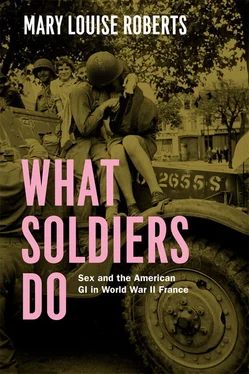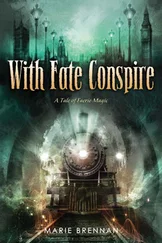6 Archives Municipales de la Ville du Havre (hereafter AMH), FC H4 15–6, letters dated 18 November and 21 November 1944, 25 June 1945. See also the letters dated 14 June, 19 June, and 19 July 1945.
7 HBO-JAG, 1:13.
8 For such a case, see HOBR, Court Martial Case (hereafter CMC) 5017, 14:53–63.
9 To a great extent, of course, rape had already been racialized in the United States. See Martha Hodes, White Women, Black Men: Illicit Sex in the Nineteenth-Century South (New Haven, CT: Yale University Press, 1996), 2–3, 176–208; and Diane Miller Sommerville, Rape and Race in the Nineteenth-Century South (Chapel Hill: University of North Carolina Press, 2004).
10 For a treatment of rape on the eastern front, see Wendy Jo Gertjejannsen, “Victims, Heroes, Survivors: Sexual Violence on the Eastern Front during World War II” (PhD thesis, University of Minnesota, 2004); Birgit Beck, “The Military Trials of Sexual Crimes Committed by Soldiers in the Wehrmacht, 1939–1944,” in Homefront: The Military, War and Gender in Twentieth-Century Germany , ed. Karen Hagemann and Stefanie Schüler-Springorum (New York: Berg, 2002), 255–74. For a comparative approach, see Raphaëlle Branche et al., eds., Viols en temps de guerre (Paris: Éditions Payot, 2011).
11 For more on rape and the Red Army, see Catherine Merridale, Ivan’s War: Life and Death in the Red Army, 1939–1945 (New York: Henry Holt and Company, 2006), chap. 9. For the rape of German women, see Atina Grossman, “A Question of Silence: The Rape of German Women by Occupation Soldiers,” October 72 (1994): 43–63; and Grossman, Jews, Germans, and Allies: Close Encounters in Occupied Germany (Princeton, NJ: Princeton University Press, 2007), chap. 3. See also Norman Naimark, The Russians in Germany: A History of the Soviet Zone of Occupation, 1945–1949 (Cambridge, MA: Harvard University Press, 1995), 69–140; and Anonymous, A Woman in Berlin: Eight Weeks in the Conquered City (New York: Metropolitan Books, 2005).
12 HBO-JAG, 1:10.
13 HBO-JAG, 1:249. There is no documentary evidence of mass rape in the Pacific Theater. However, Yuki Tanaka has used eyewitness testimonies and Japanese police intelligence reports to argue that there were gang rapes in Okinawa in March of 1945, and significant numbers of rapes in the Japanese homeland after it was occupied by the Americans in September 1945. See Yuki Tanaka, Japan’s Comfort Women: Sexual Slavery and Prostitution during World War II and the U.S. Occupation (London: Routledge, 2002), 110–11, 116–17.
14 Lilly, Taken by Force , 16, 76–77, 91.
15 See HBO-JAG, 1:10–13, 237.
16 In its final report, the Twelfth Army Group noted that in August 1944, “by far the greatest number of known off enders and suspects” for the crime of rape were “colored service troops.” See US Army, Twelfth Army Group, Final After-Action Report , 15 vols. ([Bad-Hamburg?]: Twelfth Army Group, 1945), 10:223.
17 HBO-JAG, “Introduction,” 1: np. That percentage was up from 23 percent in June, and it dipped to 28 percent in August. Although these figures are for the European theater as a whole, they apply mostly to France, where the majority of American troops were fighting during the late summer months. The rape figures for Belgium were minimal.
18 Maggie M. Morehouse, Fighting in the Jim Crow Army: Black Men and Women Remember World War II (Lanham, MD: Rowman and Littlefield Publishers, 2000), 3.
19 Stephen E. Ambrose, “Blacks in the Army in Two World Wars,” in The Military and American Society: Essays and Readings , ed. Stephen E. Ambrose and James A. Barber Jr. (New York: Free Press, 1972), 178, 182–83.
20 See Richard Dalfiume, Desegregation of the US Armed Forces, Fighting on Two Fronts, 1939–1953 (Columbia: University of Missouri Press, 1969), 31–33, 64–81.
21 Phillip McGuire, ed., Taps for a Jim Crow Army: Letters from Black Soldiers in World War II (Santa Barbara, CA: ABC-Clio, 1983), xxx–xxxvi; McGuire, He, Too, Spoke for Democracy: Judge Hastie, World War II and the Black Soldier (New York: Greenwood Press, 1988), 31; Graham Smith, When Jim Crow Met John Bull: Black American Soldiers in World War II Britain (London: I. B. Tauris & Co., Ltd., 1987), 21–24. On the boycott and the role of the black press, see Neil Wynn, The Afro-American and the Second World War (New York: Holmes & Meier, 1975), 22–26; and Allan Brandt, Harlem at War: The Black Experience in World War II (Syracuse, NY: Syracuse University Press, 1996), 109.
22 On Hastie’s appointment, see McGuire Taps , xxxi; McGuire, Hastie , xiv.
23 For the complaint letters that Hastie received at the War Department, see the William Henry Hastie Papers, Harvard Law School Library, Part IX, Segregation, Discrimination: Armed Services, Boxes 102–8 to 102–14. For the complaint letters that Hastie received through the NAACP, see Papers of the NAACP, Part 18, Special Subjects, 1940–55, Series B, General Office Files, William H. Hastie, and Part 9, Series A, Discrimination in the US Armed Forces, 1918–55, General Office Files on Armed Forces’ Affairs. Most of these complaints date from the years 1940–41 and also concern discrimination in training and promotion. In the secondary literature, see Clayborne Carson et al., African American Lives: The Struggle for Freedom (New York: Pearson Longman, 2005), 406.
24 Wynn, The Afro-American , 27; Brandt, Harlem at War , 137.
25 A pamphlet given to white officers was meant to address the “special” issues of commanding black soldiers. See Command of Negro Troops , War Department Pamphlet No. 20–6, 29 February 1944.
26 The Schomburg Center for Research in Black Culture, New York Public Library (hereafter SCRBC), James Watson Papers, Sc MG 464. See also Ruth Wilson, Jim Crow Joins Up (New York: William J. Clark, 1944), 10; Brandt, Harlem at War , 101–2; McGuire, Hastie , 67.
27 SCRBC, Layle Lane Papers, Sc MG 54 (hereafter LLP) Box 1, Folder 1, Correspondence, Soldiers, 1942–46 (hereafter 1.1 Corr.), letter dated 26 February 1943.
28 Ibid., letter dated 9 May 1943.
29 Ibid., letter dated 27 April 1943.
30 Ibid., letter dated 9 May 1943.
31 SCRBC, Committee against Jim Crow in Military Service and Training, Sc MG98, Folder 2, Hearings before Commission of Inquiry into the Effects of Segregation and Discrimination on the Morale and Development of the Negro Soldier (hereafter Folder 2). This folder contains a written transcript of hearings before a Commission of Inquiry into the Effects of Segregation and Discrimination on the Morale and Development of the Negro Soldier, May 1948. It includes testimonies from black soldiers concerning their training and deployment in the Second World War.
32 Lee, Employment of Negro Troops , 300. See also Kenneth Rose, Myth and the Greatest Generation: A Social History of Americans in World War II (New York: Routledge, 2008), 135.
33 SCRBC, LLP, 1.1 Corr., letter dated 6 April 1944.
34 SCRBC, Committee against Jim Crow in Military Service and Training, Sc MG98, Folder 2.
35 SCRBC, LLP, 1.1 Corr., letter dated 10 March 1943.
36 Ibid., letter dated 14 August 1944.
37 Ibid., letter dated 24 December 1944. See also Walter White’s exposé of racist practices in the military in England: A Rising Wind (Garden City, NY: Doubleday, Doran and Company, 1945), 16; and excerpts from Militant , 30 September 1944; “Britons Reject Racist Indoctrination,” in Fighting Racism in World War II , ed. C. L. R. James et al. (New York: Monad Press, 1980), 311. In the secondary literature, see Smith, When Jim Crow , 133–34, 139–41; and Neil R. McMillen, “Fighting for What We Didn’t Have,” in Remaking Dixie: The Impact of World War Two on the American South , ed. McMillen (Jackson: University Press of Mississippi, 1997), 97.
Читать дальше












